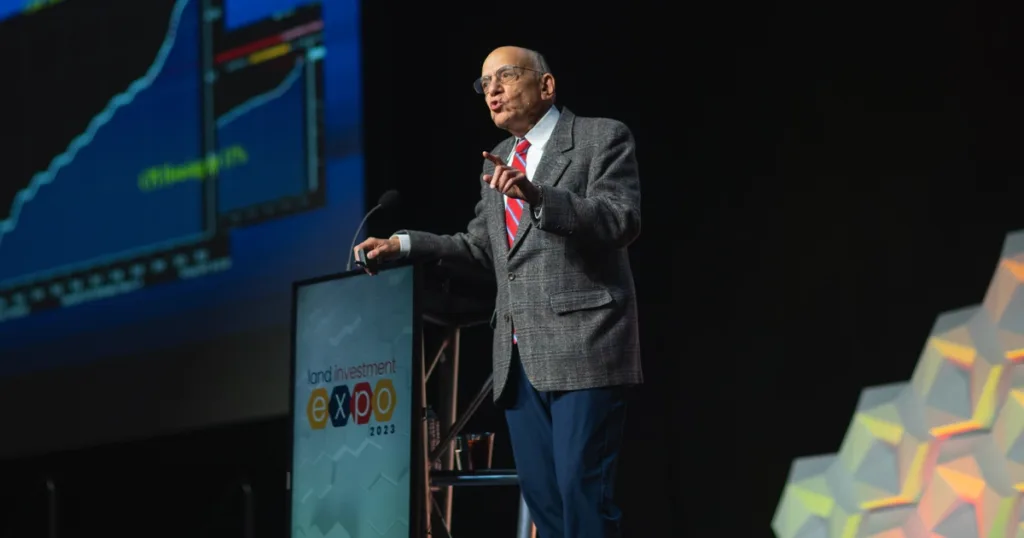Jeremy Siegel Presents His 2023 Forecast
Jeremy Siegel Presents His 2023 Forecast

LR_JeremySiegel-01
 Jeremy Siegel said a recession this year is not inevitable — but only if the Federal Reserve pivots soon. Speaking at the 2023 Land Investment Expo in Des Moines, the professor emeritus of finance at the University of Pennsylvania’s Wharton School of Business did not mince words: He believes many of the Federal Reserve’s actions since COVID-19 have been misguided.
Jeremy Siegel said a recession this year is not inevitable — but only if the Federal Reserve pivots soon. Speaking at the 2023 Land Investment Expo in Des Moines, the professor emeritus of finance at the University of Pennsylvania’s Wharton School of Business did not mince words: He believes many of the Federal Reserve’s actions since COVID-19 have been misguided.
Outlining his case, Siegel argued that, at various points post-pandemic, the Fed has been either too quick or too slow to respond to market changes, particularly regarding inflation.
“What the Fed has done is gone way too fast. Delayed way too long. And then, slammed on the brakes,” he said.
Discerning the Financial Year Ahead
Author of the lauded investment primer Stocks for the Long Run, now in its sixth edition, Siegel is a well-regarded financial expert whose opinions frequently appear in financial news briefs on CNBC, NPR, CNN, and other media outlets.
At the Land Expo, though, he was able to provide a detailed, unfiltered take on the status of the US economy across a nearly hour-long presentation.
Attendees, in other words, had a rare chance to sit in on a de facto Wharton School lecture in which facts came flying fast and the insights were many.
Here, we attempt to highlight just a few of Siegel’s most shrewd observations.

The Forecast for Asset Classes
Siegel predicted a return of 5 to 6 percent for stocks and just 3.5 percent or lower for bonds in 2023. He anticipated a return of 2.5 percent for treasury bills.
“Stocks are not very good short-term hedges; they have too much volatility. But they are almost perfect long-term hedges,” Siegel shared.
Tapping into the audience’s core asset interest later in the talk, Siegel did have unmitigatedly positive things to say about land investment.
“Land has done really well,” he said, pointedly. “Land has beaten the S&P on several return averages over the last 50 years.”
Explaining the Money Supply
Siegel showed charts illustrating historic trends of the US money supply — which includes the liquidity of individuals and businesses as well as state and local governments. Until COVID-19 hit in March 2020, the money supply had historically risen by a rate of about 5.3 percent a year.
But in the wake of emergency relief bills put into play by Congress during COVID-19, the US money supply increased 17 percent in just four months, from March to July 2020.
“It was the biggest increase in history,” Siegel said. “We have never — not during wars or anything — printed and thrown as much money into people’s accounts as we did during that time.”
The Fed continued to increase the money supply by 12 percent between July 2020 and February 2022. Then in March 2022, the trend abruptly stopped, leading to the current status: an eight-month decline in the money supply, the longest since World War II.
“It’s a real danger,” Siegel said of the money supply bottleneck. “If that continues, we are guaranteed to have a recession. There’s still a chance for a pivot, but it has to happen quickly.”
Fed Missteps
Siegel then outlined several key recent financial missteps he attributed to both the federal government and the Federal Reserve.
Specifically, he shared his opinion that the second round of Trump-approved COVID-relief payments and both rounds of Biden-enacted COVID-relief payments were unneeded. He also had harsh words for Congress’s refusal to raise taxes or cut spending but instead simply “inflate away” Americans’ dollars.
Finally, Seigel discussed at length his view that the Fed has made misguided steps regarding inflation, thanks in part to its use of what he believes are lagging national home price indexes. These metrics, he argued, caused the Fed to far understate US inflation rates early in the pandemic aftermath. The same lagging metrics are causing the Fed to now, conversely, overestimate the rate of current inflation in the marketplace.
“The Federal Reserve’s rate plan is far too hawkish,” Siegel said in summary. “If they do keep rates at 5 percent or above for the rest of the year, you can absolutely guarantee there will be a pretty severe recession in 2023.”




